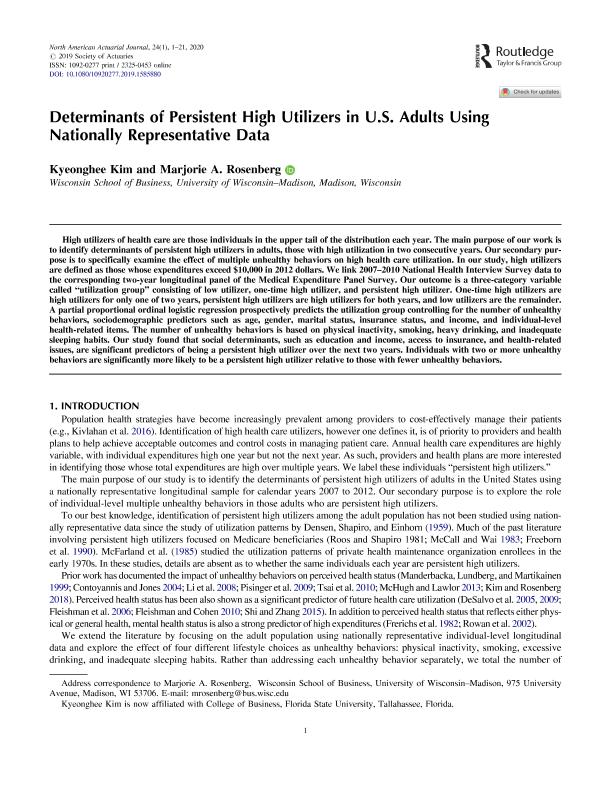Determinants of persistent high utilizers in U.S. adults using nationally representative data

Contenido multimedia no disponible por derechos de autor o por acceso restringido. Contacte con la institución para más información.
| Tag | 1 | 2 | Valor |
|---|---|---|---|
| LDR | 00000cab a2200000 4500 | ||
| 001 | MAP20200011569 | ||
| 003 | MAP | ||
| 005 | 20220911211218.0 | ||
| 008 | 200408e20200302usa|||p |0|||b|eng d | ||
| 040 | $aMAP$bspa$dMAP | ||
| 084 | $a344.1 | ||
| 100 | $0MAPA20180012037$akim, Kyeonghee | ||
| 245 | 1 | 0 | $aDeterminants of persistent high utilizers in U.S. adults using nationally representative data$cKyeonghee Kim, Marjorie A. Rosenberg |
| 520 | $aHigh utilizers of health care are those individuals in the upper tail of the distribution each year. The main purpose of our work is to identify determinants of persistent high utilizers in adults, those with high utilization in two consecutive years. Our secondary purpose is to specifically examine the effect of multiple unhealthy behaviors on high health care utilization. In our study, high utilizers are defined as those whose expenditures exceed $10,000 in 2012 dollars. We link 2007-2010 National Health Interview Survey data to the corresponding two-year longitudinal panel of the Medical Expenditure Panel Survey. Our outcome is a three-category variable called "utilization group" consisting of low utilizer, one-time high utilizer, and persistent high utilizer. One-time high utilizers are high utilizers for only one of two years, persistent high utilizers are high utilizers for both years, and low utilizers are the remainder. A partial proportional ordinal logistic regression prospectively predicts the utilization group controlling for the number of unhealthy behaviors, sociodemographic predictors such as age, gender, marital status, insurance status, and income, and individual-level health-related items. The number of unhealthy behaviors is based on physical inactivity, smoking, heavy drinking, and inadequate sleeping habits. Our study found that social determinants, such as education and income, access to insurance, and health-related issues, are significant predictors of being a persistent high utilizer over the next two years. Individuals with two or more unhealthy behaviors are significantly more likely to be a persistent high utilizer relative to those with fewer unhealthy behaviors. | ||
| 650 | 4 | $0MAPA20130012056$aGastos médicos | |
| 650 | 4 | $0MAPA20080626310$aSeguro de asistencia sanitaria | |
| 650 | 4 | $0MAPA20090043374$aAtención sociosanitaria | |
| 650 | 4 | $0MAPA20080578848$aAnálisis de datos | |
| 650 | 4 | $0MAPA20080553241$aAsegurados | |
| 650 | 4 | $0MAPA20080550592$aEncuestas | |
| 651 | 1 | $0MAPA20080638337$aEstados Unidos | |
| 700 | $0MAPA20100051672$aRosenberg, Marjorie A. | ||
| 773 | 0 | $wMAP20077000239$tNorth American actuarial journal$dSchaumburg : Society of Actuaries, 1997-$x1092-0277$g02/03/2020 Tomo 24 Número 1 - 2020 , p. 1-21 |

